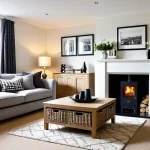Home Design and Its Direct Impact on Daily Habits in the UK
The architectural layout of UK homes plays a critical role in shaping daily living habits and routines. In the UK, home designs like terraced houses, semi-detached homes, and flats significantly influence how occupants organise their day-to-day activities. For instance, terraced homes often feature compact spaces, promoting close-knit family interactions yet limiting private areas, which affects personal time and social behaviour.
Room functionality also directs the flow of daily routines. Kitchens, often regarded as the heart of the home in the UK, guide family meal preparation and gatherings, while living rooms usually accommodate relaxation and entertainment. In flats, multifunctional rooms are common, encouraging flexible use that adapts to dynamic schedules. Meanwhile, semi-detached homes might include additional rooms serving as home offices or hobby spaces, directly impacting how residents balance work and family life.
Also to discover : How do you choose the right furniture for a small UK living room?
Overall, UK home design creates a framework that subtly influences routine behaviours. From how families interact around communal spaces to the division between personal and shared areas, the physical environment steers not only where activities happen but also how daily living habits evolve within the unique context of UK housing.
Interior Design Choices and Lifestyle Adaptation
Interior design UK plays a vital role in shaping wellbeing and accommodating evolving lifestyle choices. Thoughtful furniture placement and use of natural light foster healthier, more productive environments within UK homes. Well-placed windows that maximise daylight support circadian rhythms, reducing fatigue and improving mood, directly impacting daily living habits.
In the same genre : What are the best space-saving furniture options for UK homes?
Modern UK interiors increasingly reflect adaptations to work-from-home routines. Flexible spaces featuring ergonomic desks and comfortable seating help separate work duties from relaxation, promoting balance. Additionally, decluttered, minimalist rooms reduce stress and improve mental clarity, reinforcing positive routine influence.
Entertainment and dining areas have also evolved in UK homes. Open-plan kitchens and living rooms encourage social interaction, but strategic furniture layout maintains flow and comfort for everyday use. Choices such as multi-functional furniture and modular units enable residents to optimise limited space while supporting diverse activities.
Ultimately, interior design UK not only complements architectural layout but actively shapes daily living habits by enhancing functional comfort and wellbeing. Residents adapting their interiors find it easier to integrate work, leisure, and social needs efficiently—highlighting the crucial link between design choices and lifestyle adaptation within UK homes.







